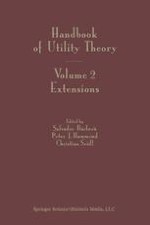2004 | OriginalPaper | Buchkapitel
Expected Utility in Non-Cooperative Game Theory
verfasst von : Peter J. Hammond
Erschienen in: Handbook of Utility Theory
Verlag: Springer US
Enthalten in: Professional Book Archive
Aktivieren Sie unsere intelligente Suche, um passende Fachinhalte oder Patente zu finden.
Wählen Sie Textabschnitte aus um mit Künstlicher Intelligenz passenden Patente zu finden. powered by
Markieren Sie Textabschnitte, um KI-gestützt weitere passende Inhalte zu finden. powered by
The theory of equilibrium in general non-cooperative games was initially developed for two-person “zero-sum” games by Borei (1921, 1924), von Neumann (1928) and von Neumann and Morgenstern (1944).1 It was then extended to general n-person games with finite strategy sets by Nash (1950, 1951). This classical theory allows different players to choose stochastically independent “mixed” strategies in the form of objective probability distributions. In this connection, Aumann (1987b, p. 466) gives a very clear and concise account of the role played by objectively expected utility theory in the classical theory of games with independent mixed strategies. A recent extension of classical non-cooperative game theory due to Aumann (1974, 1987a) allows different players to correlate their mixed strategies through some form of correlation device.2
